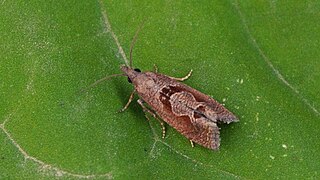
Gravitarmata margarotana, the pine cone tortrix or pine twig moth, is a moth of the family Tortricidae. In Europe, it is found from England to Austria and Poland, east to the Baltic region to Russia, China, Korea and Japan.
Epinotia rubiginosana is a moth of the family Tortricidae. It is found from Europe to eastern Russia, China, Korea and Japan.

Rhyacionia duplana, the summer shoot moth or Elgin shoot moth when referring to subspecies logaea, is a moth of the family Tortricidae. It is found from northern and central Europe to eastern Russia, China and Japan. It has also been reported from Korea, but it has not been found in recent studies.
Zeiraphera rufimitrana, the red-headed fir tortricid, is a moth of the family Tortricidae. It is found from central Europe to eastern Russia, Mongolia, the Korean Peninsula, China and Japan. It was first recorded from the Netherlands by Kuchlein and Naves in 1999.

Cydia pyrivora, the pear fruit moth or pear tortricid, is a moth of the family Tortricidae. It is found in Latvia, the Czech Republic, Slovakia, Sardinia, Sicily, the Italian mainland, Austria, Hungary, Yugoslavia, Romania, Bulgaria, Algeria, the island of Crete in Greece, Ukraine and southern and central Russia.

Paeonia tenuifolia is a herbaceous species of peony that is called the steppe peony or the fern leaf peony. It is native to the Caucasus Mountains, with large fields found in Vashlivani National Park in Georgia and the Black Sea coast of Ukraine, spreading westward into Bulgaria, Romania and Serbia and eastward to northwestern Kazakhstan. It was described by Linnaeus in 1759. The leaves are finely divided into almost thread-like segments and grow close together on the stems. This peony can reach 30–60 cm (12–24 in) in height. The scented red flowers have numerous yellow stamens in the centre.
Grapholita andabatana is a moth of the family Tortricidae. It was described by Niels Laue Wolff in 1957. It is found in Denmark, France, Switzerland, Austria, Italy, Slovakia, Poland and Russia.

Cochylidia moguntiana is a species of moth of the family Tortricidae. It is found in Spain, Sweden, Denmark, Germany, Poland, Austria, Italy, the Czech Republic, Slovakia, Croatia, Hungary, Romania, Estonia, Latvia, Lithuania, Russia, Afghanistan, Kyrgyzstan, northern Pakistan, Iran, China and Korea.

Phtheochroa schreibersiana is a species of moth of the family Tortricidae. It is found from Europe to the Near East, the Caucasus and southern Russia (Sarepta). The habitat consists of hedgerows, marshes, river-banks and other damp areas.

Thiodia torridana is a species of moth of the family Tortricidae. It is found in France, Germany, Austria, Switzerland, Italy, the Czech Republic, Slovakia, Slovenia, Hungary, Romania, Poland, Ukraine, Russia, Transcaucasia, Asia Minor, Kazakhstan, Turkmenistan and Kyrgyzstan.
Eucosma lugubrana is a species of moth of the family Tortricidae. It is found on Sicily and in France, Austria, Italy, Slovakia, Hungary, North Macedonia, Greece and Russia, Kazakhstan and Kyrgyzstan.

Eucosma metzneriana, the mugwort bell, is a species of moth of the family Tortricidae. It is found on Sicily and in Great Britain, the Netherlands, Belgium, Luxembourg, France, Germany, Denmark, Austria, Switzerland, Italy, the Czech Republic, Slovakia, Slovenia, Hungary, Bulgaria, Romania, Poland, Sweden, Finland, the Baltic region, Ukraine, Russia, North Africa, Transcaucasia, Asia Minor, Iran, Kazakhstan, Kyrgyzstan, Mongolia, China, Korea and Japan.

Eucosma pupillana is a species of moth of the family Tortricidae.

Epiblema graphana is a species of moth of the family Tortricidae. It is found in Spain, France, Germany, the Benelux, Denmark, Austria, Switzerland, Italy, the Czech Republic, Slovakia, Poland, Norway, Sweden, Finland, the Baltic region, Albania, Romania, Bulgaria, Hungary, Slovenia, North Macedonia, Greece, the Near East, Russia, Kazakhstan, Iran, Afghanistan and China.

Gibberifera simplana, the least bell, is a species of moth of the family Tortricidae. It is found in China, Taiwan, Korea, Japan, Russia and Europe, where it has been recorded from Great Britain, France, the Benelux, Germany, Denmark, Austria, Switzerland, Italy, the Czech Republic, Slovakia, Poland, Hungary, Romania, Norway, Sweden, Finland and the Baltic region.

Acleris lorquiniana, the marsh button, is a species of moth of the family Tortricidae. It is found in Iran and central and northern Europe, where it has been recorded from Great Britain, France, Belgium, the Netherlands, Germany, Denmark, Austria, Switzerland, the Czech Republic, Slovakia, Poland, Romania, Hungary, Sweden, Finland, the Baltic region and Russia. The habitat consists of damp fenland.

Acleris lipsiana is a species of moth of the family Tortricidae. It is found in Great Britain, Spain, France, Belgium, the Netherlands, Germany, Denmark, Austria, Switzerland, Italy, the Czech Republic, Slovakia, Hungary, Poland, Greece, Norway, Sweden, Finland, the Baltic region and Russia. It is also found in North America, where it has been recorded from Alberta and Washington. The habitat consists of high moors and mountainous areas.
Acleris obtusana, the small aspen leaftier moth, is a species of moth of the family Tortricidae. It is found in Norway, Sweden, Finland, Estonia and Latvia. It is also found in Russia and North America, where it has been recorded from Alberta, Indiana, Maine, Michigan, Montana, New Hampshire, New York, Ontario, Vermont and Wisconsin.

Acleris umbrana is a species of moth of the family Tortricidae. It is found in Great Britain, France, Belgium, Germany, Austria, Switzerland, Italy, the Czech Republic, Slovakia, Poland, Hungary, Norway, Sweden, Finland, the Baltic region and Russia. In the east, the range extends to Japan. The habitat consists of woodland, fens and marshes.

Eucosma similiana is a species of moth of the family Tortricidae. It is found in North America, where it has been recorded from the north-eastern United States and south-eastern Canada. The habitat consists of fields and waste areas.

















